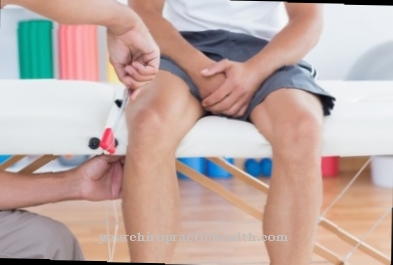In addition to tasting, seeing, feeling, hearing and smelling, people can use their Deep sensitivity orientate. This ability enables him to assume a certain position and make movements. If it is disturbed, it can lead to accidents and disabilities in everyday life.
What about the deep sensitivity?

Depth sensitivity (Bathyesthesia) describes the part of the self-perception that relates to the perception of the stimuli inside the body. These deeper areas of the body are muscles, tendons, and joints. With the help of its ability to perceive, the body continuously informs the spinal cord and brain about its position, posture and position (e.g. limbs).
The depth sensitivity is made up of sense of position, sense of movement and sense of strength. In addition, there is the sensation of the body position in the room. The receptors (proprioreceptors) necessary for receiving the stimuli are, for example, tendon spindles (Golgi apparatus) and muscle spindles in the skeletal muscles. In the connective tissue of the joint capsule, fibers register every change in speed and every change of direction. The Golgi apparatus monitors muscle tone.
After the stimuli are perceived, they are passed on to the spinal cord, where they are immediately answered by triggering a specific reflex. Then a message is sent to the brain. The sensory impression is evaluated there and answered with a reaction. It consists, for example, in changing posture.
A large part of the processes involved in proprietary reception run subconsciously. Our psyche reacts with this protective mechanism in order not to be overwhelmed with information. Conscious and unconscious depth perceptions use different paths to the brain. The proprioception works 24 hours a day without interruption, even while sleeping.
Function & task
Due to the deep sensitivity, the person is able to assess in which position his body is currently (sitting, standing, etc.). He can accurately assess his posture during a certain movement or in a resting position. For example, he recognizes that the right foot is not exactly next to the left or that he is bending his upper body slightly forward.
In addition, people can use certain stimuli to judge their applied strength and experienced resistances. The three semicircular canals in the equilibrium organ of the ear convey an exact picture of the three-dimensionality of space. In the atrial sacs, which are also located there, there are receptors that register the smallest changes in speed and pass them on to the organs in the periphery, where the corresponding actions are triggered. Finding that the speed of rotation has changed enables the carousel-driving child, for example, to accurately recognize their parents, who are a little further away.
The motor skills are controlled by the strength and sense of movement. There are conscious and unconscious actions that are carried out with muscle power. Through certain receptors in the eye muscles, humans are able to recognize the expansion of space and their body as a whole. If there are movements that are associated with muscle contractions, the person feels positive feelings.
How important depth perception is for people is shown, for example, by the unsteady gait of people who are under the influence of alcohol. They are no longer able to walk in a straight line and fall because they misjudge the distance between the ground and their own feet. The alcohol disrupts the stimuli transmitted from inside the body by the receptors.
You can find your medication here
➔ Medicines for paresthesia and circulatory disordersIllnesses & ailments
A disturbed deep sensitivity can lead to a general hypersensitivity. The person concerned can no longer control his movements and can no longer adequately dose the associated force. He reacts clumsily or with inappropriately exerted force, and some patients refrain from moving because of the low muscle tone.
Another disturbance of depth perception is in the form of syringomyelia. In this very rare disease, there is a more or less large cavity (syrinx) filled with liquor in the spinal cord at the level of the cervical spine. The cavity is filled with dead nerve cells that expand and press on the surrounding nerves, causing neurological breakdowns. The health disorder is congenital or acquired through an accident. The first symptoms usually appear from the second decade of life.
The patient has severe neck, arm, shoulder and headaches and numbness in his limbs. Since he does not know where the arms and legs are, he can no longer control their movements. He has spastic or flaccid paralysis, visual, hearing, speech or swallowing disorders. The inadequate ability to coordinate movements leads to unsteady gait and falls. If the affected person also develops circulatory disorders due to the Syrinx, his skin feels cold and sometimes shows a bluish discoloration. Depending on the extent of the disease, the doctor can treat his patient with physiotherapy and pain therapy. In severe cases, surgery is required. A permanent shunt is usually placed or a foramen magnum decompression operation is performed to remove CSF and reduce pressure.

























.jpg)


